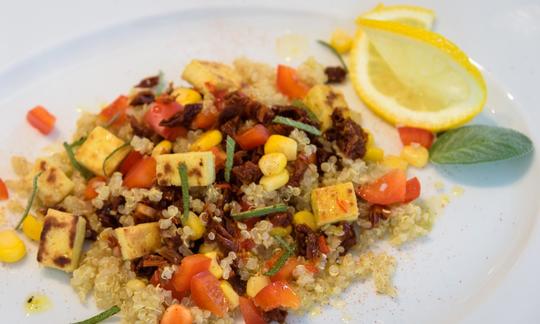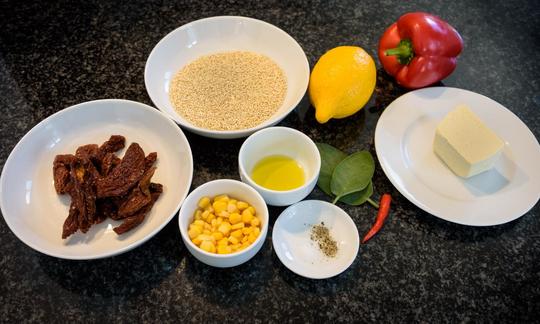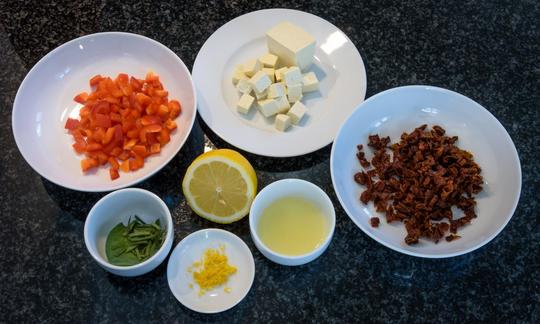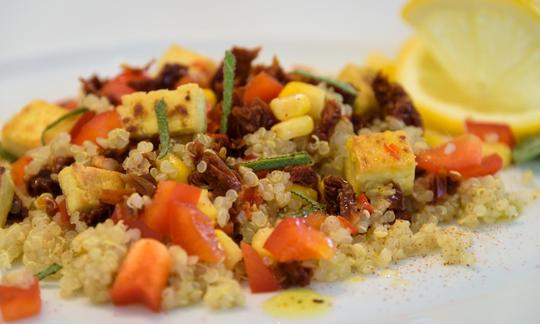Quinoa salad with dried tomatoes, sage and tofu
vegan
Ingredients (for servings, )
| For the quinoa salad | |
|---|---|
| 5 ½ oz | Quinoa, raw, peeled (organic?) |
| 300 ml | Drinking water, raw (organic?) (11 oz) |
| 5 ½ oz | Tomatoes, dried (raw?, organic?) |
| 1 | Sweet peppers, red, raw (organic?) (5.8 oz) |
| 3 leaves | Sage, common (medicinal sage, kitchen sage) (0.01 oz) |
| 1 ¾ oz | Sweet corn kernels, preserved (organic?) |
| 7 ⅓ oz | Tofu, tasteless (bean curd) |
| 1 tsp | Rapeseed oil (canola, HOLL oil, kernel oil), cold pressed?, organic? (0.16 oz) |
| For the dressing | |
| ½ | Lemons, raw (limes, organic?) (1.0 oz) |
| ½ | Chili peppers, red, raw (organic?) (0.09 oz) |
| 1 tbsp | Rapeseed oil (canola, HOLL oil, kernel oil), cold pressed?, organic? (0.49 oz) |
| ½ tsp | Paprika powder, hot (raw?, organic?) (0.04 oz) |
| 1 dash | Table salt (table salt, raw?, organic?) (0.01 oz) |
| 1 dash | Black pepper (organic?, raw?) (0.00 oz) |
Equipment
- grater
- skillet (frying pan)
- stove
- citrus juicer (lemon squeezer)
- saucepan
Type of preparation
- cook
- chop or grind
- squeeze
- sauté
- grate (shred)
Preparation
For the quinoa salad
Cook the quinoa in tap water until soft, about 20 minutes.Meanwhile, cut the dried tomatoes and peppers into small pieces and the sage into thin strips. Mix together with the corn.
Cut the tofu into small cubes and fry it in a pan with rapeseed oil on all sides until it turns a brownish color.
Drain the quinoa, add to the vegetables and mix.
For the dressing
Grate the peel of half a lemon and squeeze out the juice. Deseed the chili and cut into thin strips. Mix together with the oil and spices.It is best to use an unsprayed organic lemon for the lemon zest. Otherwise, rinse the lemon thoroughly with hot water.
The amount of chili depends on your taste for spiciness and the type of chili. Please adjust the amount to suit your individual needs.
Add the dressing to the quinoa salad and mix thoroughly.
serving
Arrange the quinoa salad on plates and spread the tofu on top.
|
Nutritional Information per person
Convert per 100g
|
2000 kcal | |
|---|---|---|
| Energy | 328 kcal | 16.4% |
| Fat/Lipids | 12 g | 16.6% |
| Saturated Fats | 1.3 g | 6.5% |
| Carbohydrates (inc.dietary fiber) | 45 g | 16.8% |
| Sugars | 18 g | 20.0% |
| Fiber | 8.1 g | 32.4% |
| Protein/Albumin | 16 g | 31.3% |
| Cooking Salt (Na:119.6 mg) | 304 mg | 12.7% |
| Essential micronutrients with the highest proportions | per person | 2000 kcal | |
|---|---|---|---|
| Vit | Vitamin C (ascorbic acid) | 72 mg | 90.0% |
| Min | Copper, Cu | 0.89 mg | 89.0% |
| Min | Manganese, Mn | 1.7 mg | 84.0% |
| Elem | Potassium, K | 1'634 mg | 82.0% |
| Elem | Magnesium, Mg | 243 mg | 65.0% |
| Prot | Tryptophan (Trp, W) | 0.15 g | 59.0% |
| Min | Iron, Fe | 7.6 mg | 55.0% |
| Elem | Phosphorus, P | 377 mg | 54.0% |
| Prot | Threonine (Thr, T, irreversibly transaminated) | 0.46 g | 49.0% |
| Vit | Vitamin B9, B11 (Folate, as the active form of folic acid) | 92 µg | 46.0% |
Detailed Nutritional Information per Person for this Recipe
The majority of the nutritional information comes from the USDA (US Department of Agriculture). This means that the information for natural products is often incomplete or only given within broader categories, whereas in most cases products made from these have more complete information displayed.
If we take flaxseed, for example, the important essential amino acid ALA (omega-3) is only included in an overarching category whereas for flaxseed oil ALA is listed specifically. In time, we will be able to change this, but it will require a lot of work. An “i” appears behind ingredients that have been adjusted and an explanation appears when you hover over this symbol.
For Erb Muesli, the original calculations resulted in 48 % of the daily requirement of ALA — but with the correction, we see that the muesli actually covers >100 % of the necessary recommendation for the omega-3 fatty acid ALA. Our goal is to eventually be able to compare the nutritional value of our recipes with those that are used in conventional western lifestyles.
| Essential fatty acids | per person | 2000 kcal |
|---|---|---|
| Linoleic acid; LA; 18:2 omega-6 | 4.2 g | 42.0% |
| Alpha-Linolenic acid; ALA; 18:3 omega-3 | 0.78 g | 39.0% |
| Essential amino acids | per person | 2000 kcal |
|---|---|---|
| Tryptophan (Trp, W) | 0.15 g | 59.0% |
| Threonine (Thr, T, irreversibly transaminated) | 0.46 g | 49.0% |
| Isoleucine (Ile, I) | 0.48 g | 39.0% |
| Lysine (Lys, K, irreversibly transaminated) | 0.64 g | 35.0% |
| Phenylalanine (Phe, F) | 0.53 g | 34.0% |
| Leucine (Leu, L) | 0.80 g | 33.0% |
| Valin (Val, V) | 0.53 g | 33.0% |
| Methionine (Met, M) | 0.18 g | 20.0% |
| Vitamins | per person | 2000 kcal |
|---|---|---|
| Vitamin C (ascorbic acid) | 72 mg | 90.0% |
| Vitamin B9, B11 (Folate, as the active form of folic acid) | 92 µg | 46.0% |
| Vitamin K | 24 µg | 32.0% |
| Vitamin B1 (Thiamine) | 0.31 mg | 28.0% |
| Vitamin B3 (Niacin) | 4.5 mg | 28.0% |
| Vitamin B6 (pyridoxine) | 0.39 mg | 28.0% |
| Vitamin B2 (Riboflavin) | 0.38 mg | 27.0% |
| Vitamin E, as a-TEs | 2.3 mg | 19.0% |
| Vitamin B7 (Biotin, ex vitamin H) | 9.5 µg | 19.0% |
| Vitamin B5 (Pantothenic acid) | 0.99 mg | 17.0% |
| Vitamin A, as RAE | 117 µg | 15.0% |
| Essential macroelements (macronutrients) | per person | 2000 kcal |
|---|---|---|
| Potassium, K | 1'634 mg | 82.0% |
| Magnesium, Mg | 243 mg | 65.0% |
| Phosphorus, P | 377 mg | 54.0% |
| Calcium, Ca | 156 mg | 20.0% |
| Sodium, Na | 120 mg | 15.0% |
| Essential trace elements (micronutrients) | per person | 2000 kcal |
|---|---|---|
| Copper, Cu | 0.89 mg | 89.0% |
| Manganese, Mn | 1.7 mg | 84.0% |
| Iron, Fe | 7.6 mg | 55.0% |
| Zinc, Zn | 2.6 mg | 26.0% |
| Selenium, Se | 13 µg | 23.0% |
| Fluorine, F | 53 µg | 2.0% |
| Iod, I (Jod, J) | 2.8 µg | 2.0% |
This spicy quinoa salad with dried tomatoes, sage and tofu tastes light and fresh. It is perfect as a side dish or as a main course.
Quinoa: Quinoa, which comes from South America, is a so-called pseudo-cereal, as it is not a cereal from a botanical point of view, but a goosefoot plant. This is why quinoa is gluten-free and is therefore also suitable for people with gluten intolerance. Quinoa contains around 15 percent more protein than other cereals and is ideal for low-carb cooking. For vegetarians and vegans, it is a valuable source of protein away from meat. Since it contains all the amino acids essential for humans, it is considered particularly valuable.
Spiciness of chilis: Chilies, whose family also includes sweet peppers, have very different degrees of spiciness. It is important to note that the smaller ones are not always the hottest.
Basically, the spiciness of a chili pepper decreases from the base of the fruit to the tip. You can also reduce the spiciness by removing the septa and seeds of the chili. This is where most of the capsaicin is found. Some well-known types of chili are (in increasing order of spiciness): pepperoni, sambal, jalapeño chili, cayenne pepper and piri-piri.
Tofu and production: This Asian food, sometimes known colloquially as bean curd, is particularly popular with vegetarians and vegans due to its high protein content. It is also lactose, cholesterol and gluten free.
The first step in making tofu is to extract soy milk. This is made by soaking soybeans in water, then pureeing and cooking them. The latter serves to remove toxins that inhibit digestion. The next step is to curdle the soy milk using coagulants such as calcium sulfate or nigari (in Okinawa, sea water is used for this purpose; the product is known as "island tofu"), which can sometimes separate soy protein components from the rest of the mass. The protein flakes are then pressed into solid tofu blocks, which are then cut into suitable shapes after cooling. The production of tofu blocks differs depending on the type of tofu.
True sage: True sage ( Salvia officinalis) is a medicinal plant whose fresh or dried leaves are used as a medicinal drug. The main active ingredients in sage include essential oils containing thujone, linalool and 1,8-cineole. As a remedy, sage is usually used in the form of a herbal tea, with dissolved ingredients being used to combat digestive problems, excessive sweating and inflammatory diseases of the mouth and throat. Nevertheless, sage should be used in moderation, as the monoterpene ketone "thujone" contained in the essential oil has a toxic effect in higher doses and can cause cramps as well as an increased heart rate. In addition, the consumption of sage tea leads to the milk flow drying up in nursing mothers and is only suitable for weaning in such a situation.
Chili preparation: It is best to wear gloves when handling the chilies, as the spiciness sticks to your hands very well and can lead to unwanted contamination. Especially for people who wear lenses, this can lead to very painful events when removing the lenses, even if 1-2 hours have passed since cooking.
Tofu - possible uses: The manufacturing process of tofu described in the instructions shows that it consists of pressed tofu protein components. Since these are tasteless, unseasoned tofu varieties have practically no taste of their own. This makes it ideal as a carrier of spices and flavors, which explains its diverse uses. In addition to being a component of main dishes, you can also use tofu for desserts. In East Asian cuisine, tofu is often eaten natural or only lightly seasoned.
Canned sweet corn: Canned sweet corn tastes sweet. This is because additives (e.g. sugar or salt) are usually added during production. You should keep this in mind if you use canned corn instead of fresh corn! It is recommended that you rinse the canned kernels with tap water before further processing and then let them drain.
Vegetable variations: You can use other vegetables, such as carrots or zucchini strips, instead of the ingredients listed.










